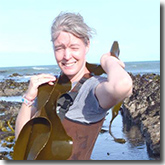Names are important to us as museum scientists. The scientific name is a key index for specimens and the hierarchy implicit in binomial nomenclature is essential to the organization of collections. Names also reveal historical connections, folklore, and biology of the organisms.
The scientific name is always given as a binomen, a two-part name consisting of a genus and species. As the words themselves suggest, the genus name is more “general” than the species name, identifying the larger group to which a species belongs. The genus name is capitalized and the species name is not, and by convention, both are rendered in italics (or underlined when handwritten). The genus name can be abbreviated to a single (uppercase) letter (e.g., H. sapiens, E. coli). The application of a binomen is governed by a series of rules (called the codes of nomenclature) devised and agreed upon by the scientific community. The nomenclature of animals differs slightly from that of plants (and fungi), reflecting the different histories and cultures of zoology and botany. The rules are designed to support and facilitate the description of biodiversity and include provisions for resolving conflicts in the application of names.
Many species (including ours!) have both a scientific name and common (or vernacular) name. Unlike the scientific name, which is the same in every language, a common name is generally language-specific and may even differ within a language across regions or over time.
Take for example Anemonia viridis. The common name for this species in England is “the snakelocks anemone.” In Dutch, it’s “wasroos,” and in French, it’s “anémone de mer verte.” These common names emphasize different things about the animals–the long tentacles (English), the texture (Dutch), and the color (French).
In many cases, the common name and scientific name are essentially the same name – scientific names often have roots in Greek or Latin and the common name may be a translation of this (or vice versa -the scientific name may be a Latinization of a common name).
Nematostella vectensis – the “starlet sea anemone” is a great example. The name for the genus translates to “threadlike star,” which aptly describes its appearance.
Common names generally highlight the appearance or biology of a species, but may provide a glimpse into its history or refer to some aspect of its biology. For example, Lucernaria janetae was named to honor Dr. Janet Voight, a marine biodiversity scientist at the Field Museum. Janet was the motivating force behind the research expedition on which these deep-sea stalked jellyfish were collected.
In the nineteenth century, as part of broad enthusiasm for natural history, common names were chosen for many species that had previously escaped popular attention. For sea anemones, this meant a proliferation of names like “the Crimson Pufflet,” “the Sprawlet,” and “the Gem Pimplet.” As fanciful as these names seem, there is an internal logic to them: all of the species called Pufflets belong to the same group, as do the various Pimplets. The coiner of these common names was Philip Henry Gosse, a British naturalist and author who had better success with another of his invented words, “aquarium,” a portmanteau of “aquatic” and “vivarium.” Sadly, despite Gosse’s best efforts, common names are generally not used for anemones in English-speaking countries, with the exception of very common and widespread species or those sold through the aquarium trade.
 About the Author: Dr. Meg Daly is Professor in the department of Evolution, Ecology and Organismal Biology, director of the Museum of Biological Diversity and leads the laboratory of marine invertebrate diversity at OSU. She and her students study systematics of cnidaria, sea anemones, jellyfish and their like.
About the Author: Dr. Meg Daly is Professor in the department of Evolution, Ecology and Organismal Biology, director of the Museum of Biological Diversity and leads the laboratory of marine invertebrate diversity at OSU. She and her students study systematics of cnidaria, sea anemones, jellyfish and their like.
All photos taken by the author.


